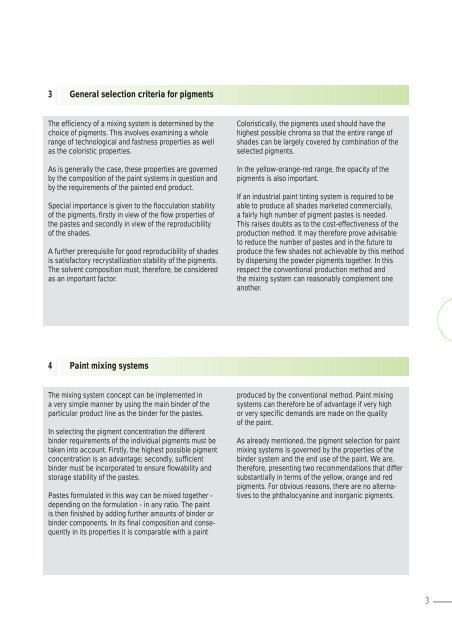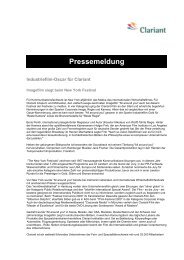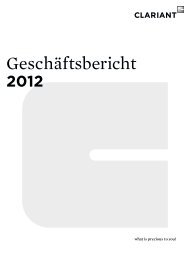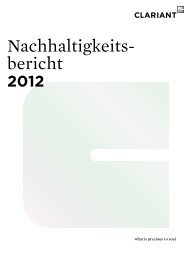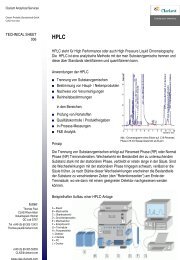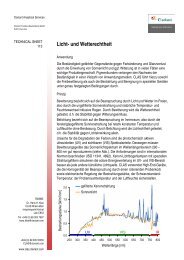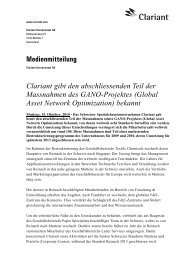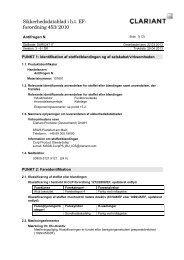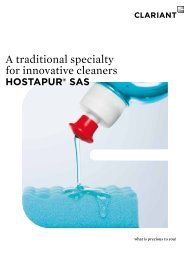DP 8525 ED_March09_E_Green.QXP - Clariant
DP 8525 ED_March09_E_Green.QXP - Clariant
DP 8525 ED_March09_E_Green.QXP - Clariant
Sie wollen auch ein ePaper? Erhöhen Sie die Reichweite Ihrer Titel.
YUMPU macht aus Druck-PDFs automatisch weboptimierte ePaper, die Google liebt.
3 General selection criteria for pigments<br />
The efficiency of a mixing system is determined by the<br />
choice of pigments. This involves examining a whole<br />
range of technological and fastness properties as well<br />
as the coloristic properties.<br />
As is generally the case, these properties are governed<br />
by the composition of the paint systems in question and<br />
by the requirements of the painted end product.<br />
Special importance is given to the flocculation stability<br />
of the pigments, firstly in view of the flow properties of<br />
the pastes and secondly in view of the reproducibility<br />
of the shades.<br />
A further prerequisite for good reproducibility of shades<br />
is satisfactory recrystallization stability of the pigments.<br />
The solvent composition must, therefore, be considered<br />
as an important factor.<br />
4 Paint mixing systems<br />
The mixing system concept can be implemented in<br />
a very simple manner by using the main binder of the<br />
particular product line as the binder for the pastes.<br />
In selecting the pigment concentration the different<br />
binder requirements of the individual pigments must be<br />
taken into account. Firstly, the highest possible pigment<br />
concentration is an advantage; secondly, sufficient<br />
binder must be incorporated to ensure flowability and<br />
storage stability of the pastes.<br />
Pastes formulated in this way can be mixed together -<br />
depending on the formulation - in any ratio. The paint<br />
is then finished by adding further amounts of binder or<br />
binder components. In its final composition and consequently<br />
in its properties it is comparable with a paint<br />
Coloristically, the pigments used should have the<br />
highest possible chroma so that the entire range of<br />
shades can be largely covered by combination of the<br />
selected pigments.<br />
In the yellow-orange-red range, the opacity of the<br />
pigments is also important.<br />
If an industrial paint tinting system is required to be<br />
able to produce all shades marketed commercially,<br />
a fairly high number of pigment pastes is needed.<br />
This raises doubts as to the cost-effectiveness of the<br />
production method. It may therefore prove advisable<br />
to reduce the number of pastes and in the future to<br />
produce the few shades not achievable by this method<br />
by dispersing the powder pigments together. In this<br />
respect the conventional production method and<br />
the mixing system can reasonably complement one<br />
another.<br />
produced by the conventional method. Paint mixing<br />
systems can therefore be of advantage if very high<br />
or very specific demands are made on the quality<br />
of the paint.<br />
As already mentioned, the pigment selection for paint<br />
mixing systems is governed by the properties of the<br />
binder system and the end use of the paint. We are,<br />
therefore, presenting two recommendations that differ<br />
substantially in terms of the yellow, orange and red<br />
pigments. For obvious reasons, there are no alternatives<br />
to the phthalocyanine and inorganic pigments.<br />
3


